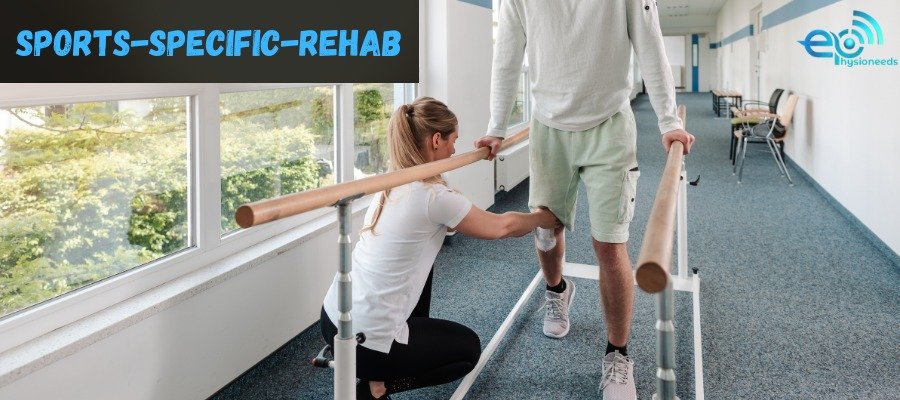Table Of Contents
Introduction
Understanding Sports-Specific Rehabilitation
The Importance of Sports-Specific Rehabilitation
The Key Components of Sports-Specific Rehabilitation
The Role of Rehabilitation Specialists
Case Studies: Real-Life Examples
The Psychological Aspect
Preventing Future Injuries
Conclusion
Introduction
Sports injuries are an unfortunate but common occurrence in the world of athletics. Whether you’re a professional athlete or someone who enjoys recreational sports, injuries can disrupt your training and performance. This is where sports-specific rehabilitation comes into play, offering a structured approach to recovery that not only heals injuries but also enhances athletic performance. In this blog, we will explore the importance of sports-specific rehabilitation, its key components, and how it can help athletes regain their strength, agility, and confidence.
Understanding Sports-Specific Rehabilitation
Definition and Purpose
Sports-specific rehabilitation is a specialized form of physical therapy designed to address injuries or medical conditions that affect an athlete’s ability to perform at their best. Unlike general rehabilitation, which focuses on basic functionality, sports-specific rehabilitation tailors the treatment to the specific demands of an athlete’s sport. The primary purpose is not only to heal the injury but also to restore optimal performance levels.
The Importance of Sports-Specific Rehabilitation
Effective rehabilitation is crucial for athletes because it:
- Facilitates faster recovery.
- Reduces the risk of re-injury.
- Helps athletes regain confidence.
- Enhances overall performance.
The Key Components of Sports-Specific Rehabilitation
Assessment and Diagnosis
The journey towards recovery starts with a thorough assessment and diagnosis of the injury. This involves a combination of medical history, physical examinations, and often advanced imaging techniques like MRI or X-rays. The goal is to understand the extent of the injury, its specific location, and how it affects the athlete’s ability to perform.
Goal Setting
Once the diagnosis is established, the next step is to set clear rehabilitation goals. These goals should be tailored to the athlete’s sport and performance level. For example, a soccer player recovering from a knee injury might have goals related to regaining strength, balance, and agility specific to the demands of soccer.
Individualized Treatment Plans
Sports-specific rehabilitation is not a one-size-fits-all approach. Each athlete’s treatment plan should be personalized to address their unique needs and goals. This may involve a combination of techniques such as physical therapy exercises, manual therapy, and modalities like heat or cold therapy.
Progressive Exercises
Rehabilitation typically starts with gentle exercises aimed at reducing pain and inflammation. As the athlete progresses, the exercises become more sports-specific and challenging. This progression helps athletes rebuild strength, endurance, and skill relevant to their sport.
Sport-Specific Drills
One of the defining features of sports-specific rehabilitation is the incorporation of drills and exercises that mimic the movements and demands of the athlete’s sport. For example, a golfer recovering from a shoulder injury may practice golf swings with gradually increasing intensity to ensure a seamless return to the game.
Monitoring and Adjustments
Rehabilitation is an evolving process. Sports-specific rehab programs are continually monitored, and adjustments are made as needed. This ensures that the athlete’s progress aligns with their goals and helps prevent setbacks.
The Role of Rehabilitation Specialists
Physical Therapists
Physical therapists are at the forefront of sports-specific rehabilitation. They work closely with athletes to design and implement customized treatment plans. These plans may include a combination of hands-on techniques, exercises, and education on injury prevention.
Athletic Trainers
Athletic trainers are essential members of the sports medicine team. They provide on-field care, injury prevention strategies, and collaborate with other healthcare professionals to ensure athletes receive comprehensive care.
Sports Physicians
Sports physicians play a vital role in diagnosing and managing sports injuries. They often work in tandem with physical therapists and athletic trainers to provide a holistic approach to rehabilitation.
Case Studies: Real-Life Examples
To illustrate the effectiveness of sports-specific rehabilitation, let’s explore a couple of case studies:
Case Study 1: ACL Tear in a Basketball Player
- Diagnosis: A professional basketball player sustains an ACL tear, a common injury in the sport.
- Rehabilitation: The athlete undergoes surgery followed by a carefully planned rehabilitation program.
- Key Elements: Early post-op recovery, progressive strengthening exercises, balance and agility drills, sport-specific training.
- Outcome: The athlete makes a successful return to the court, performing at pre-injury levels.
Case Study 2: Runner’s Stress Fracture
- Diagnosis: An amateur marathon runner is diagnosed with a stress fracture in the shin.
- Rehabilitation: Treatment involves rest, controlled weight-bearing exercises, gait analysis, and a gradual return to running.
- Key Elements: Rest, load management, gait analysis, progressive running program.
- Outcome: The runner not only heals but also improves running form and avoids future injuries.
The Psychological Aspect
Rehabilitation isn’t just physical; it’s psychological too. Athletes often face frustration, anxiety, and fear during the recovery process. Sports-specific rehabilitation programs often include mental conditioning to help athletes stay motivated and confident throughout their journey.
Preventing Future Injuries
A significant advantage of sports-specific rehabilitation is its focus on injury prevention. By addressing weaknesses, imbalances, and faulty movement patterns during rehabilitation, athletes are better equipped to avoid future injuries.
Conclusion
In the world of musculoskeletal health, sports-specific rehabilitation is a game-changer for athletes. It’s not just about recovering from injuries; it’s about reaching new heights of performance. Through individualized treatment plans, sport-specific drills, and a dedicated team of healthcare professionals, athletes can heal, grow stronger, and return to their sport with newfound confidence. So, whether you’re a professional athlete or a weekend warrior, remember that sports-specific rehabilitation is your path to peak performance. In conclusion, sports-specific rehabilitation is a critical component of an athlete’s journey towards recovery and peak performance. This comprehensive approach addresses not only the physical aspects of injury but also the psychological and preventive elements, ensuring that athletes come back stronger and better prepared to excel in their chosen sports.
At Ephysioneeds Academy, we offer comprehensive training for physiotherapists looking to progress their skills. Our courses include dry needling certification, advanced physiotherapy techniques, and sports injury treatment. Our rehabilitation certification and physiotherapy training online provide flexibility and depth. We moreover specialize in manual therapy courses and soft tissue therapy certification. Explore our sports fellowship in physiotherapy and detailed A-Z knee and shoulder treatment courses. Additionally, the Tapedia Taping Encyclopedia is an essential resource for mastering taping techniques.

